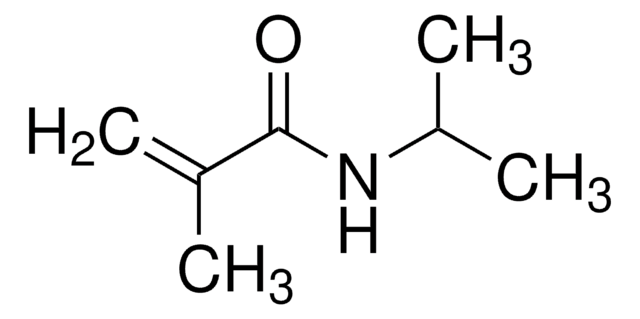535311
Poly(N-isopropylacrylamide)
Mn ~40,000
Sinónimos:
NIPAM polymer, PNIPAM, Polyacrylamide, polyNIPAM
About This Item
Productos recomendados
mol peso
Mn 20,000-60,000
Mn ~40,000
mp
96 °C
cadena SMILES
CC(C)NC(=O)C=C
InChI
1S/C6H11NO/c1-3-5-7-6(8)4-2/h4H,2-3,5H2,1H3,(H,7,8)
Clave InChI
WDFKEEALECCKTJ-UHFFFAOYSA-N
¿Está buscando productos similares? Visita Guía de comparación de productos
Aplicación
Forma física
Código de clase de almacenamiento
11 - Combustible Solids
Clase de riesgo para el agua (WGK)
WGK 1
Punto de inflamabilidad (°F)
Not applicable
Punto de inflamabilidad (°C)
Not applicable
Equipo de protección personal
Eyeshields, Gloves, type N95 (US)
Elija entre una de las versiones más recientes:
¿Ya tiene este producto?
Encuentre la documentación para los productos que ha comprado recientemente en la Biblioteca de documentos.
Los clientes también vieron
Artículos
The present publication focuses on synthesis and characterization of nanothick, chemically grafted polymer films (polymer brushes) on various inorganic and polymeric substrates.
Poly(N-isopropylacrylamide), or PNIPAM, is a stimuli-responsive polymer that responds to changes in pH and temperature and has a LCST around 32 C.
Tissue engineering has become a key therapeutic tool in the treatment of damaged or diseased organs and tissues, such as blood vessels and urinary bladders.
By altering the physicochemical properties, smart or intelligent drug delivery systems can be designed to deliver therapeutic molecules on-demand. Learn more about the application of stimuli-responsive materials in drug delivery.
Nuestro equipo de científicos tiene experiencia en todas las áreas de investigación: Ciencias de la vida, Ciencia de los materiales, Síntesis química, Cromatografía, Analítica y muchas otras.
Póngase en contacto con el Servicio técnico








